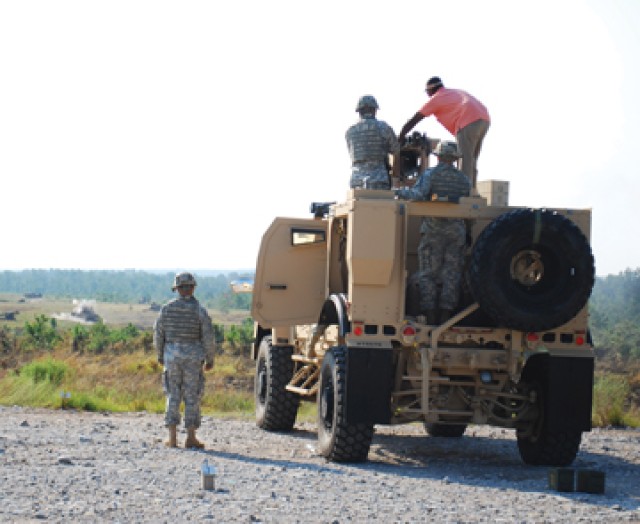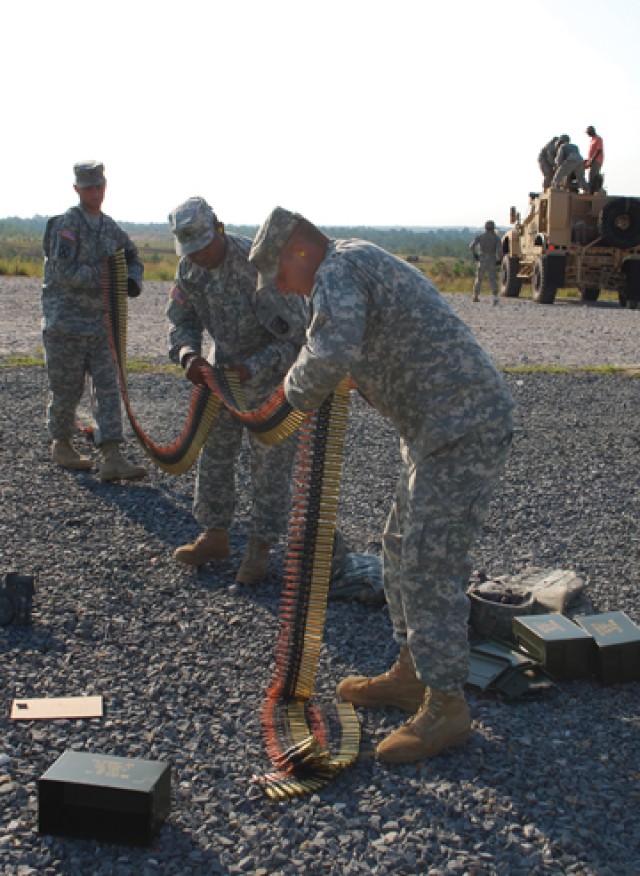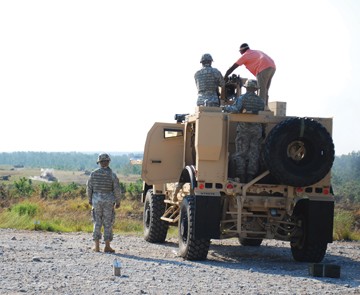FORT POLK, La. -- Technology makes life easier. In the Army, technological advances sometimes serve to protect human life. One of the most dangerous positions in the Army is the convoy gunner, but technology has found a way to keep gunners safe.
Fort Polk Soldiers trained on the Common Remotely Operated Weapon Station from Aug. 23-27. CROWS is a turret mounted atop a military vehicle that the Soldier operates from within his vehicle. CROWS-mountable vehicles include Max Pros, RG-31s, Fox vehicles, certain tanks and buffalos. Guns that can be mounted into the CROWS include the .50 caliber M2, MK19, M240B and M249.
Members of Tank-automotive and Armaments Command based out of Rock Island, Ill. taught the course to Soldiers from companies throughout Fort Polk using a train-the-trainer format.
CROWS' turret mount has a video camera, thermal imaging module and laser range finder. The gun mounted to CROWS is sighted to the cameras on the turret so few adjustments need to be made to fire the weapon at what is on the screen.
"Exactly where you point is where the bullets land," said Spc. Landon Barton of the 258th Military Police Company, 519th Military Police Battalion, 1st Maneuver Enhancement Brigade.
"It has better optics than any human eye will ever have," said Mike Fisher, TACOM training specialist. "The Soldier inside the vehicle can see further and it is capable of working both day and night. Soldiers won't be sitting out there with night vision like they had to do back in older generations."
"The thermal on it is very clear and you can see everything with the zooming," said Spc. Travis Gustafson of the 272nd Military Police Company, 519th MP Bn, 1st MEB. "I'm confident that when I'm running it at night I will be able to see what I need to see."
"This is the coolest thing I've seen in a while," said Sgt. Antoine Gray of the 258th MP Co. "When the class started on Monday, they were doing a brief run through and they had the thing moving around, and everyone's mouths were dropping."
As advanced as the imaging and technology is for CROWS, its main purpose is to eliminate the exposure to enemy fire Soldiers must face in the turret position.
"It's about keeping Soldiers out of harm's way," said Fisher. "They are actually inside a vehicle and not putting their heads above."
"The gunners, an important part of any convoy, are safe within the confines of the vehicle," said Staff Sgt. Peter King, Headquarters and Headquarters Company, 4th Battalion, 353rd Infantry Regiment, 162nd Infantry Brigade.
CROWS also reduces environmental distractions and improves visual acuity.
"I've been a gunner and on a truck, you have your goggles on, you've got the heat, wind and debris," said Gray. "With CROWS you are with your team within the truck, you don't have to worry about the elements - the heat, especially in Iraq, is ridiculous."
Most of the Soldiers taking this initial course are going to teach CROWS. Mike Freed, the CROWS site lead from TACOM, expressed honestly and optimistically how the group of Soldiers was doing learning the new system.
"They're doing good," said Freed when they tested the system on the range Aug. 27. "Don't get me wrong; everyone has their own way of learning. Some people have got to be shown, some people go ahead and fail and then they learn, and others just grab it right away. We've got enough high-speed guys out here that have been around the .50 caliber, that it's mainly just aiming the target and pushing the button. It's a good team out here."
"The instructors showed us everything we needed to know, and it's easy to use," said Barton.
"This is the most in-depth training I've been to in a while," said Gray. "The CROWS system has a lot of pieces, and the instructors take the time to break it down to where you follow every weapon that goes in there. They are very good at making sure you understand before they move on."
"The only difficult thing is the mounting and the timing," said Gustafson. "The controls are self-explanatory. It would only take a couple of hours to explain how to use it."
The system set up is reminiscent of a video game. The Soldier sights the target with a video monitor and pivots the turret with a joystick. The kick of the recoil is muffled with springed shock absorbers, further separating the Soldier from the experience of shooting the weapon directly.
"Firing from the turret itself, you have a lot of recoil, so a couple of rounds go above where you're aiming," said Gustafson.
"(With CROWS) you have a screen and a joystick, and that's it," said King. "The simulator itself is a video game system. You just have to remember that it is still a machine gun designed to do a job, a very specific job, and we have to give it the respect it deserves."
Remote weapons systems have been used by the military, but CROWS is the latest advancement.
Gray operated an RWS in 2006 in New Baghdad in Iraq. Gray preferred the new system to the old. "I would say it's about 100 times better," said Gray. "It has many extra features on it."
New updates to the CROWS include programmable movement so that the Soldier operating the station as a surveillance station will be able to concentrate on what is on the screen rather than constantly moving the system back and forth to those areas in the environment he is watching.
"In theater, if you have more than one object that you are looking at, you can time it to where it will shift every five seconds to a different object or area," said Gray. "It's a constantly rotating surveillance."
The new system also performs ballistics calculations to adjust targeting for factors such as distance and wind. "Ninety percent of the time it will put you right on target, without any calculations yourself," said Gray.
"I hope we get one down range, because I'm deploying in January," said Gustafson. "It would definitely put me at ease being in the vehicle."
"I hope this is the future of the Army, because this is a great system," said Barton. "Hopefully it gets spread around more."




Social Sharing